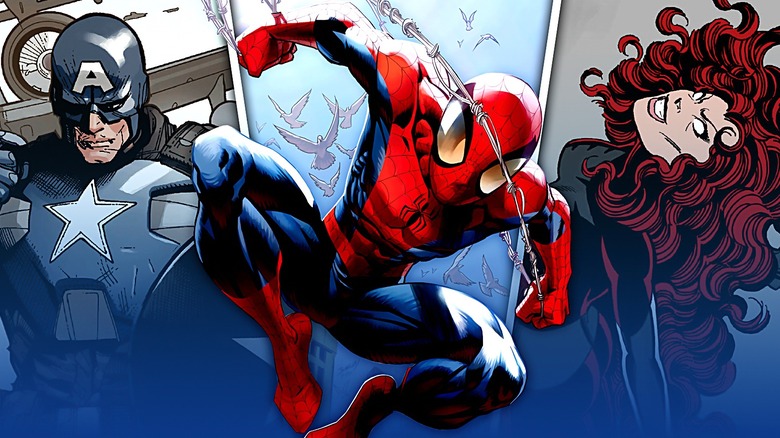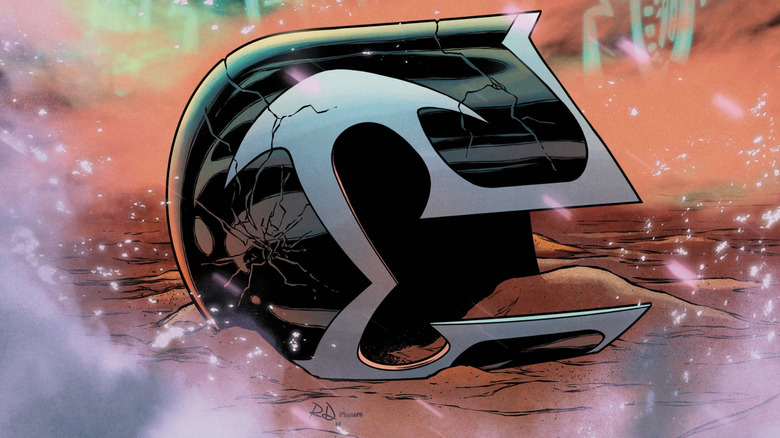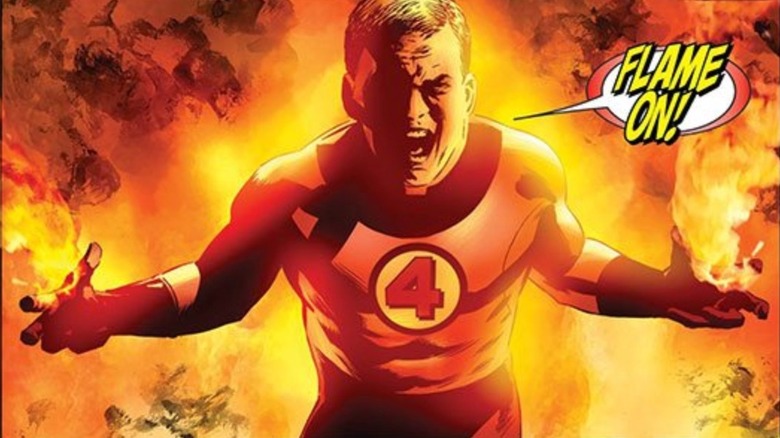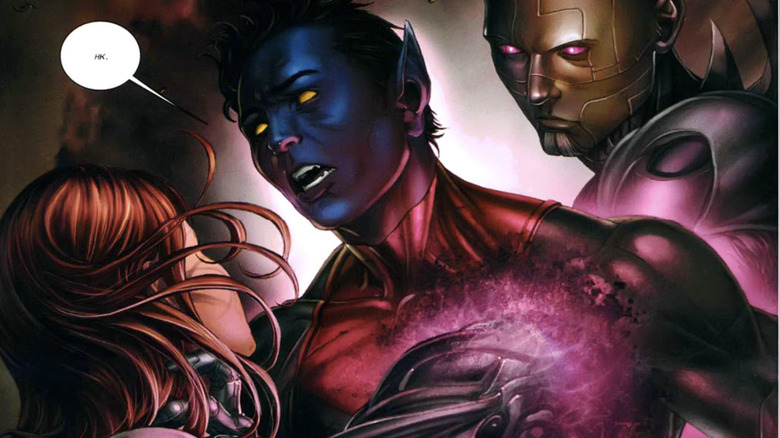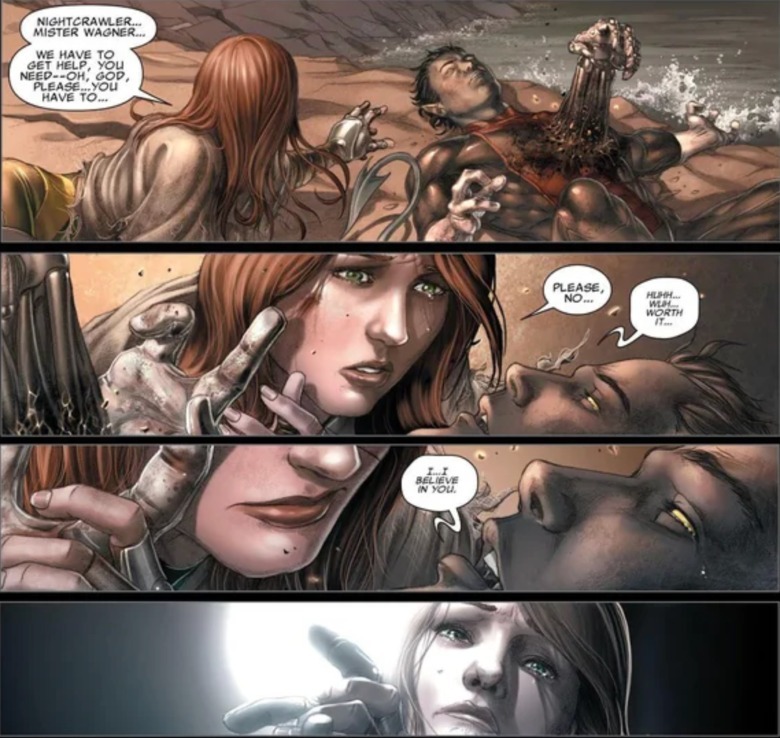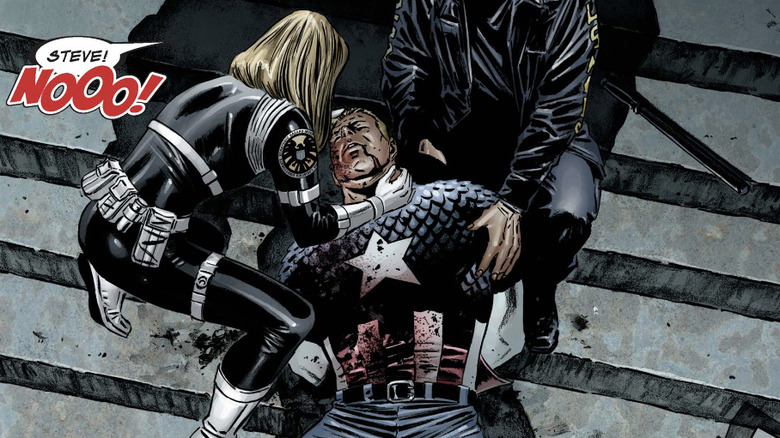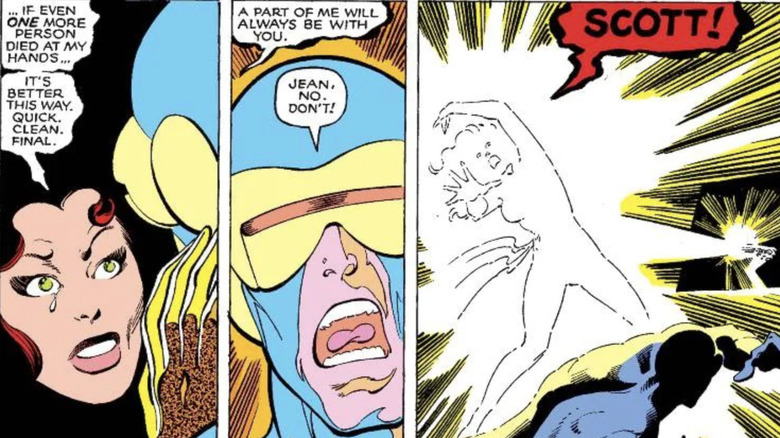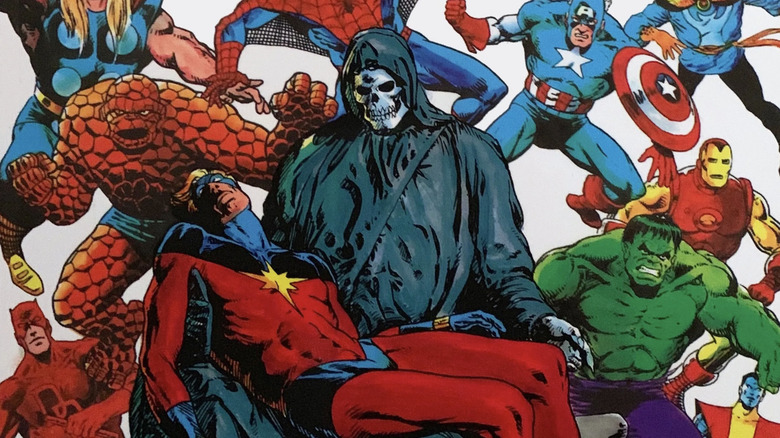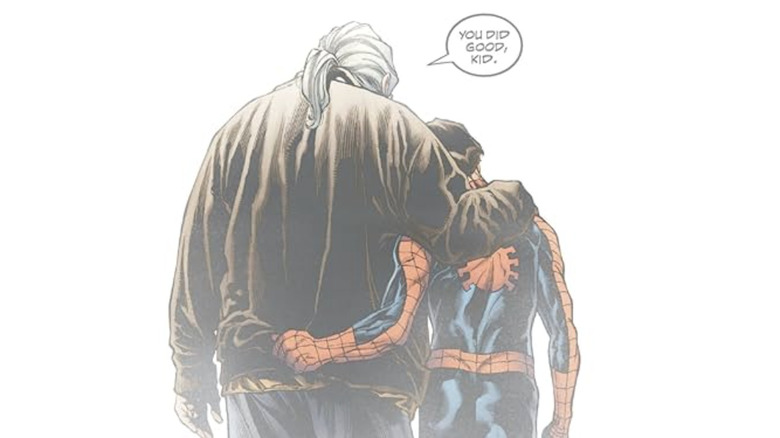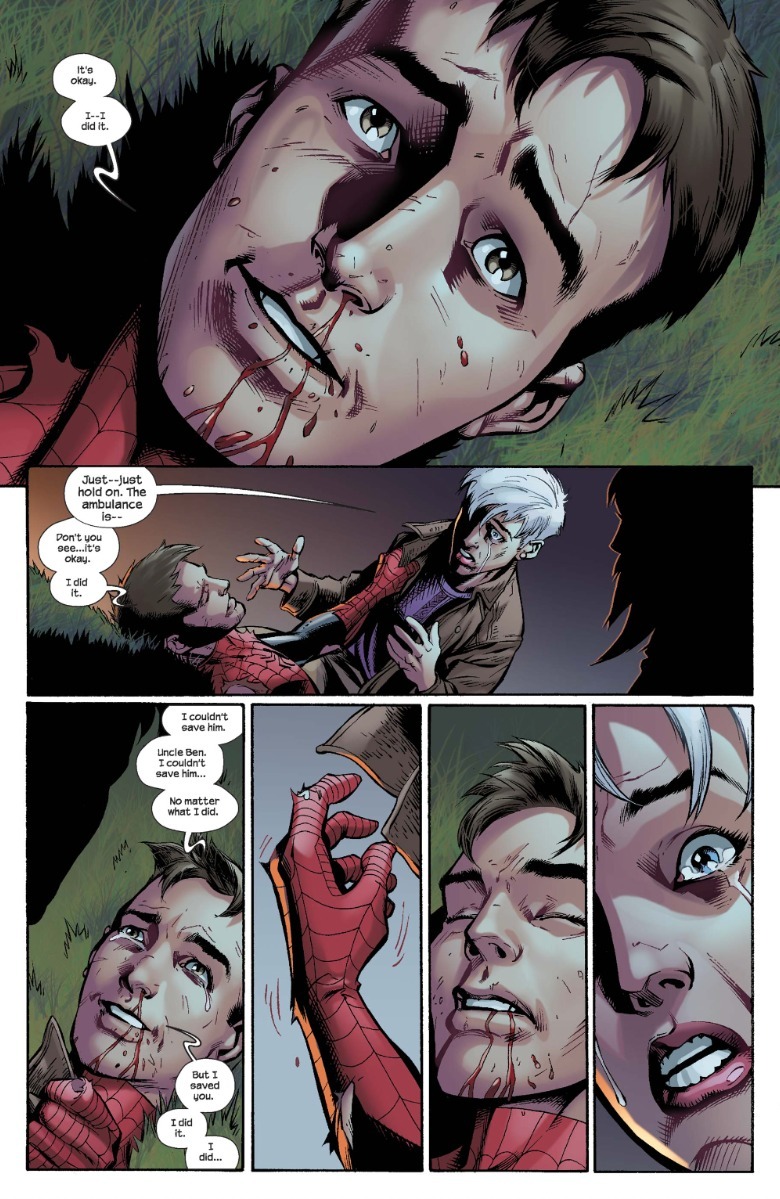The Saddest Last Words Of Marvel Superheroes
Marvel superheroes have had some memorable last moments on film. Tony Stark (Robert Downey Jr.) affirming one last time "I am Iron Man" before annihilating Thanos with a finger snap in "Avengers: Endgame." "Logan" has Wolverine (Hugh Jackman) dying a peaceful death with his heart in his hands, finally knowing the last answer all people receive: "So this is what it feels like." Remy LeBeau, currently deceased after the shocking "X-Men '97" episode "Remember It," stopped the completion of a mutant genocide by detonating the Sentinel that skewered him, giving his life with one last boast: "The name's Gambit — remember it!"
But while a handful of superheroes have died in the movies, many more have in the comics. Since the 1992 event "The Death of Superman," it's pretty much become a right of passage for any Marvel or DC character deemed important enough to receive a headlining death and then resurrection. Now, just because these deaths rarely stick doesn't make their last words any less poignant.
Get some tissues — here are the saddest last words ever printed in a Marvel comic.
7. Magneto (Judgment Day/X-Men: Red #7)
Is Magneto a hero or villain? Depends on the story, but in the last five years (since the start of the X-Men's Krakoa era, carried over into current phase "From The Ashes), he's been sitting on the X-Men's side. In that time, Magnus has journeyed into and returned from the undiscovered country.
In Al Ewing's "X-Men: Red," Magneto, Storm, and Sunspot move to Mars (recently terraformed into a new mutant homeworld, Arrako). During the crossover event "Judgment Day," the evil Eternal Uranos is unleashed on Arrako and Magneto is mortally wounded. He dies in Storm's arms; a fitting end, since Ororo is the X-Man closest to Erik besides Charles Xavier. (Way back in "Uncanny X-Men" #150, she was the one who first witnessed Magneto's remorse and encouraged him to be good).
Magneto, who gives one of his famous soliloquies even as the air escapes his body, tells Storm to "watch" Xavier. "We must be wary of good men. For what will they not do... to show how good they are?"
As he dies, Magneto sees his daughter Anya (but to make it sadder, neither we nor Storm do). Living through the Holocaust as a young Jewish man first scarred Magneto, but what convinced him that mutants could not find acceptance was when a mob burned his home, leaving Anya to die as well. "She's proud of me. I'll be right there, my dove. I'll..."
His words trail off there, but Magneto's work was not done — for Storm ventures into the afterlife to bring him back in Ewing and Luciano Vecchio's "Resurrection of Magneto."
6. Johnny Storm, The Human Torch (Fantastic Four #587)
The Fantastic Four are a family more so than any other superhero team. What happens when there's a death in that family? Jonathan Hickman answered that during his "Fantastic Four" run when he briefly killed off Johnny Storm, aka the Human Torch. The six-part story arc "Three" climaxes in "Fantastic Four" #587 (by Hickman and Steve Epting) with Johnny giving his life and leaving the Four down to, well, just Three.
In the Negative Zone, Annihilus and his Annihilation Wave are marching towards Earth, so the FF have built an interdimensional shield. To activate it, Johnny stays behind, throwing Ben Grimm/The Thing behind the shield so he doesn't have to sacrifice himself. In a moment homaging Spock's death in "Star Trek II: The Wrath of Khan," Johnny and Ben place their hands on opposite sides of the shield, unable to truly touch each other.
Turning back to face Annihilus, Johnny declares "Flame On" and goes out fighting, turning his show-off catch phrase into a declaration of defiance. FF archnemesis Doctor Doom once said great men "embrace doom and laugh in its face," and the Human Torch absolutely did that.
Johnny's spot on the team is taken by longtime family friend Spider-Man. In "Fantastic Four" #588, Peter consoles Franklin Richards (son of Johnny's sister Sue); if anyone knows what it's like to lose an uncle, it's Spider-Man.
5. Nightcrawler (X-Men: Second Coming)
The 2000s were a rough time for the X-Men thanks to the mutant "Decimation." To recap: 2005's "House of M" features Wanda Maximoff/The Scarlet Witch declaring "No more mutants," rewriting reality so that less than 200 mutants remain.
The 2007 crossover event "Messiah Complex" centers around the first mutant child to be born after the Decimation. To ensure the baby's survival, Cable takes her into the future. He returns with his grown-up adopted daughter Hope Summers in time for 2010's "Second Coming." Meanwhile, Bastion rallies anti-mutant forces to snuff out mutant hope once and for all.
In "Second Coming" chapter five ("Uncanny X-Force" #26 by Craig Kyle, Christopher Yost, Mike Choi, and Adi Granov), Nightcrawler gives his life to save Hope. As Bastion reaches out to grab her, Nightcrawler teleports between them; he materializes with Bastion's arm protruding through his chest.
Nightcrawler teleports himself and Hope away and spends his last moments telling Hope his sacrifice was for a worthy cause. "I... I believe in you," Kurt whispers as he cradles a crying Hope's face. Nightcrawler, the Catholic with the face of a demon but the soul of a hero, was a man of faith to his last breath.
4. Captain America (Captain America #25)
Mark Millar and Steve McNiven's "Civil War" was fought over superhumans disagreeing about the government attempting to register them. The mini-series ended with Captain America, leader of the rebels, choosing to surrender. Ed Brubaker, writer of "Captain America," capitalized on that ending for his plans to kill Steve Rogers and turn Bucky Barnes into Captain America.
"Captain America" #25 (by Brubaker and Epting) opens with Steve being escorted to his trial. While walking up the courthouse steps, he's shot twice and mortally wounded. The first shot comes from Crossbones with a sniper rifle, and the second, killing one comes from Cap's own lover, SHIELD Agent Sharon Carter (brainwashed into a puppet by the Red Skull's forces). With his dying words, Steve begs Sharon that "no more innocents [be] hurt." To the end, Cap was near-messianic in his selflessness.
Brubaker killing off Captain America via assassination is a pointed choice, inspiring easy comparisons to Abraham Lincoln or John F. Kennedy. With Cap dead (but not for long), the Red Skull backs a slow rolling coup and the question of the series becomes if America's soul can endure in such troubled times.
3. Jean Grey (X-Men #137, The Dark Phoenix Saga)
1980's "The Dark Phoenix Saga" (published through "X-Men" #129-137, written by Chris Claremont, drawn by John Byrne) broke a lot of Marvel Comics rules, so much so they stayed broken. Turning a hero into a villain? Killing off main characters (and, later, bringing them back years afterward)? Those were story concepts still mostly unheard of in superhero comics. They're used plenty today, but so old hat that none can rival the original trendsetter.
In "X-Men" #137, Jean Grey is fearful of what might happen if the Dark Phoenix persona takes control of her again. (Last time it did, she destroyed a whole solar system.) So, she sets an automatic gun to vaporize herself, telling her beloved Scott Summers/Cyclops that she loves and will miss him in her last moment. Before Scott can stop it, Jean is turned to dust.
Even more memorable than Jean's last conversation with Scott is her eulogy, delivered by Uatu the Watcher: "Jean Grey could have lived to become a God. But it was more important to her that she die... a human." Self-sacrifice to defeat a villain is one of the most common ways superheroes die, but for Jean Grey, the villain was inside herself.
2. Captain Marvel (The Death of Captain Marvel)
1982's "The Death of Captain Marvel" is a triple-length comic event, written and drawn by Marvel Cosmic master Jim Starlin (creator of Thanos). It stands out among many similar "Death of X" comics for two reasons. One, Captain Marvel's death is not grandiose; he's merely succumbing to cancer. The Bronze Age of Comics (1970s and 1980s) saw a big trend to humanize heroes and drag them into reality. This stands as one of the obvious examples, showing kids that superheroes could die from disease too.
Second, barring some brief exceptions, this death has stuck. (The only entry on this list that has, in fact.) Mar-Vell being dead is the status quo of the Marvel Universe that must be returned to, especially since others (like Carol Danvers, once Ms. Marvel) now wear the title.
In the last pages of "The Death of Captain Marvel," Mar-Vell meets the spirit of his old, currently dead enemy Thanos, who beckons him across the bridge of life and eternity, guiding Mar-Vell to meet Death. "Is that all there is to it? A kiss and I'm beyond the veil? I expected more," Mar-Vell observes (in reality, he flatlines). Mar-Vell, Death, and Thanos walk hand-in-hand, the latter promising his old foe that death is not the end, but a beginning.
1. Peter Parker, The Ultimate Spider-Man (Ultimate Spider-Man #160)
Brian Michael Bendis and Mark Bagley rebooted Spider-Man for the new millennium in "Ultimate Spider-Man." 160 issues later, they brought Peter Parker's story to a violent close. Shot by the Punisher during an earlier fight, Peter can't go to the hospital because he spots his greatest enemies (led by Norman Osborn/The Green Goblin) headed to his Aunt May's house in Queens.
Bleeding out the entire time, Spider-Man protects his remaining family but succumbs to his wounds. With his last words, he remembers what set him on this path (failing to save his Uncle Ben) and feels satisfied that, this time, he saved Aunt May. After that, Peter dies, with Mary Jane holding his body and sobbing. To rub salt in the wound, the last panel of the issue is a close-up of Osborn's dead body smiling, satisfied that in death he took Peter with him.
Despite introducing Miles Morales as a replacement Spider-Man with artist Sara Pichelli, Bendis ultimately couldn't resist bringing Peter back to life. (He had Miles continue as Spider-Man, though, while letting Peter and MJ ride off into the sunset.) For late millennial comic readers, "Ultimate Spider-Man" is the definite Spider-Man saga, told by one writer and devoid of the retcons that have so hampered the "mainstream" Spider-Man story. Choosing to bring Peter Parker's story to a definitive close, and like this no less, was a breathtaking decision.
